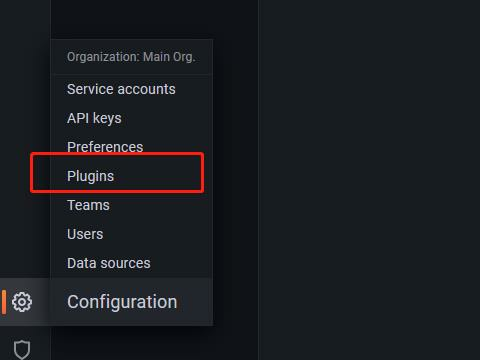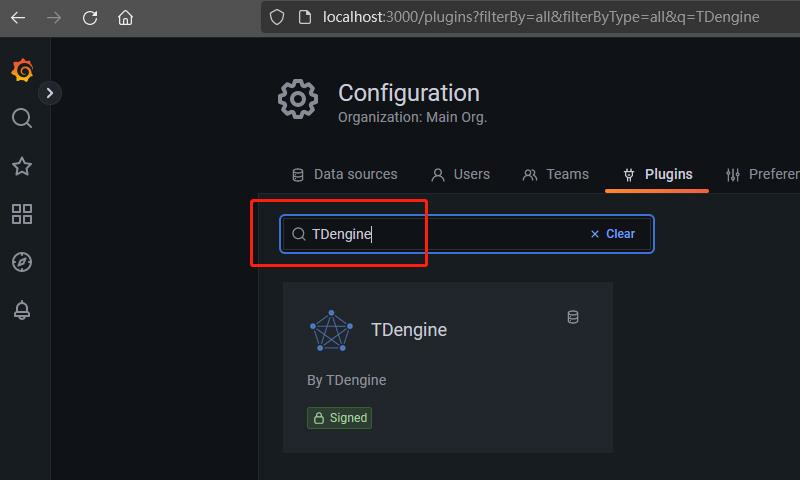[TDengine] is open-sourced big data platform under GNU AGPL v3.0, designed and optimized for the Internet of Things ( IoT), Connected Cars, Industrial IoT, and IT Infrastructure and Application Monitoring, developed by TDengine.
[TDengine] data source plugin is developed for [Grafana]. This document explains how to install and configure the data source plugin, and use it as a time-series database. We'll take a look at the data source options, variables, querying, and other options specific to this data source.
At first, please refer to Add a data source for instructions on how to add a data source to Grafana. Note that, only users with the organization admin role can add data sources.
| TDengine grafana plugin version | major changes | TDengine version |
|---|---|---|
| 3.5.1 | update taosd and taosX dashboard | 3.3.0.0 or later |
| 3.5.0 | new taosd and taosX dashboard | 3.2.3.0 or later |
| 3.4.0 | new adapter dashboard | 3.2.0.1 or later |
| 3.2.7 | support TDengine 3.0 | 3.0.0.0 or later |
TDENGINE_DS_NAME=TDengine
TDENGINE_CLOUD_URL=
TDENGINE_CLOUD_TOKEN=
bash -c "$(curl -fsSL https://raw.githubusercontent.com/taosdata/grafanaplugin/master/install.sh)"TDengine_DS_NAME: The data source name to createTDENGINE_CLOUD_URL: The TDengine url, eg.http://localhost:6041TDENGINE_CLOUD_TOKEN: The TDengine cloud service token, optional.TDENGINE_USER/TDENGINE_PASSWORD: The TDengine username/password, optional.
Type install.sh --help for the full usage of the script.
The TDengine data source plugin is already published as a signed Grafana plugin. You can easily install it from Grafana Configuration GUI. In any platform you already installed Grafana, you can open the URL http://localhost:3000 then click plugin menu from left panel.
Then key in TDengine to search.
We recommend you use the prebuilt package of the plugin in the latest release download page.
Option 1, you can install the TDengine data source plugin with grafana-cli.
sudo -u grafana grafana-cli \
--pluginUrl https://github.com/taosdata/grafanaplugin/releases/download/v3.1.3/tdengine-datasource-3.1.3.zip \
plugins install tdengine-datasourceOption 2, you can install the plugin manually.
# make sure to use the right plugins directory
GF_PLUGINS_DIR=/var/lib/grafana/plugins
# install plugin
V=3.1.7
wget -c https://github.com/taosdata/grafanaplugin/releases/download/v$V/tdengine-datasource-$V.zip
sudo -u grafana unzip -oq tdengine-datasource-$V.zip -d $GF_PLUGINS_DIR
sudo -u grafana sh -c "chmod +x $GF_PLUGINS_DIR/tdengine-datasource/tdengine-datasource*"Here is a unified shell script to automatically download and install the latest plugin in a Grafana server.
# make sure to use the right plugins directory
GF_PLUGINS_DIR=/var/lib/grafana/plugins
get_latest_release() {
curl --silent "https://api.github.com/repos/taosdata/grafanaplugin/releases/latest" |
grep '"tag_name":' |
sed -E 's/.*"v([^"]+)".*/\1/'
}
install_plugin() {
V=$1
[ -f tdengine-datasource-$V.zip ] ||
wget -c https://github.com/taosdata/grafanaplugin/releases/download/v$V/tdengine-datasource-$V.zip
sudo -u grafana unzip -oq tdengine-datasource-$V.zip -d $GF_PLUGINS_DIR
sudo -u grafana sh -c "chmod +x $GF_PLUGINS_DIR/tdengine-datasource/tdengine-datasource*"
}
install_plugin $(get_latest_release)Option 3, if you use the plugin in docker, just set the environment GF_INSTALL_PLUGINS
like GF_INSTALL_PLUGINS=https://github.com/taosdata/grafanaplugin/releases/download/v3.1.3/tdengine-datasource-3.1.3.zip;tdengine-datasource,
or refer
to Build and run a Docker image with pre-installed plugins
to pre-build a custom Grafana image with the TDengine data source plugin.
Option 4, build and install this plugin by yourself. You should follow the CONTRIBUTING steps to set up develop environment and build the plugin.
yarn build:allThen copy the dist/ directory to Grafana plugin directory.
sudo -u grafana rsync -rlzP dist/ /var/lib/grafana/plugins/tdengine-datasourceIt will also generate a zipped package named tdengine-datasource-<version>.zip for distribution.
Note that the plugin has not been published to https://grafana.com officially (the plugin is under review, as if you
want to know) - that means the plugin is unsigned for public use. So if you use it in 7.x and 8.x of grafana, you should
configure in /etc/grafana/grafana.ini by add these lines to allow unsigned plugin before start the Grafana server.
[plugins]
allow_loading_unsigned_plugins = tdengine-datasourceOr use environment variable GF_ALLOW_LOADING_UNSIGNED_PLUGINS=tdengine-datasource in docker and other container-based
environments.
In any particular scenario, if you need a signed plugin, please follow the Sign a plugin instructions to sign a private plugin. Commands may be like this:
export GRAFANA_API_KEY=<YOUR_API_KEY>
yarn run grafana-toolkit plugin:sign \
--signatureType private \
--rootUrls 'http://localhost:3000'rootUrls is your local grafana server url.
The next step is restart the Grafana server. The new data source should now be available in the data source type dropdown in the Add Data Source view. For systemd based system, the restart command is:
sudo systemctl restart grafana-serverFor SysVInit based system (CentOS 6 etc.):
sudo service grafana-server restartThe best way to install Grafana is to use Homebrew with which to install the most recent released version of Grafana using Homebrew package.
Open a terminal and enter:
brew update
brew install grafanaNext, add TDengine’s plugin with the following command:
sudo grafana-cli --pluginsDir /opt/homebrew/var/lib/grafana/plugins --pluginUrl\
https://github.com/taosdata/grafanaplugin/releases/download/v3.1.3/tdengine-datasource-3.1.3.zip \
plugins install tdengine-datasourceThe pluginsDir option /opt/homebrew/var/lib/grafana/plugins should be overridden if the directory not exist(that
will depend on how you install the Grafana service).
You can check the plugins directory to see if tdengine-datasource plugin installed:
$ ls /opt/homebrew/var/lib/grafana/plugins
tdengine-datasourceTDengine plugin has not been signed, so you should change the grafana configuration to allow unsigned plugin.
Since you are using macOS with Homebrew, Grafana instances installed using Homebrew require you to edit
the grafana.ini file directly. The way to change the grafana.ini file is to run the following command:
open -a textedit /opt/homebrew/etc/grafana/grafana.iniNote that, this plugin is signed since v3.1.7. If you are using an older version, please configure to allow loading unsigned plugins:
First, open the file, search for
;allow_loading_unsigned_pluginsThen, delete the semicolon to uncomment it, and change the line to:
allow_loading_unsigned_plugins = tdengine-datasourceAfter that, go ahead and save the configuration file.
(Re-)start Grafana service:
# brew services start grafana
brew services restart grafanaPoint to plugins pages to search and check TDengine plugin is in the list.

